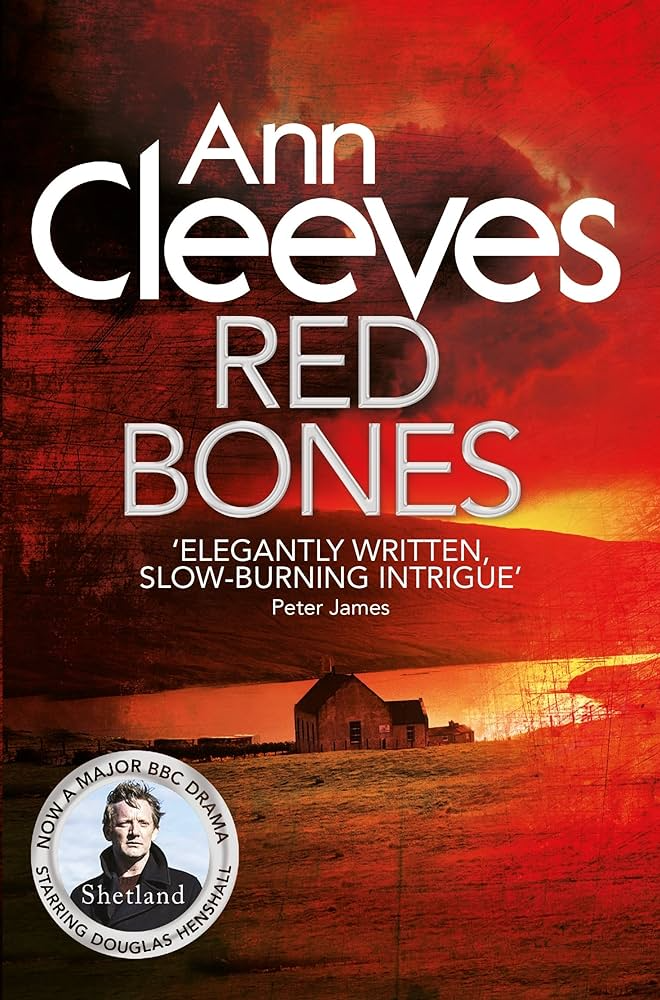Both of Ann Cleeves’ Shetland books that I’ve so far read have been steeped themselves in a sense of the place – how could they not be – but Red Bones goes all in. The phrase itself is a reference to a story told to a child: that bones go read when they’ve been in the earth for a long time. The bones in this tale vary in age: some maybe date back to the 16th century, but it’s a discovery of bones assumed lost from the 1940s that leads to a double murder and an attempted third. Red Bones is an astonishingly rich exploration of the positive and destructive power of place and the hold that it can have across generations, how it can push people away and draw people in.

Now, the idea of bones being stories that are buried and uncovered is on one level pretty unsubtle, but the feud that is uncovered has been playing out in plain sight for decades. There is a rivalry between two families that is visible, daily, to them both. The claustrophobic role of the Whalsay wife, who makes a home while their man battles the elements in a trawler or tends an inhospitable croft, requires it.
Yet Whalsay is not necessarily an inward-looking backwater. Like the rest of Shetland it was an important trading port in the Hanseatic League. Shetland itself was also the home of the ‘Shetland Bus’, the special operations group that carried out manoevres between the islands and German-occupied Norway. The legacy of both play a huge part in the plot of this novel, and enable us to contrast the relationship with Whalsay that might be had by newcomers and by inhabitants from established families.
For Anna, and for Hattie, Whalsay offers an exciting future. Anna wants to fuse the traditional crafts into a modern educational tourism business. She fell in love with Whalsay, and perhaps with her husband Ronald. And Hattie, a gifted archaeologist, wants never to leave this island where she feels more at peace than anywhere else. They represent an alternative path for Whalsay, but wield comparatively little power against the established but unstable forces of the existing residents. And it’s worth pointing out that the other non-islanders such as Sophie and Berglund are quite unsmitten by the island. Neither can wait to get off.
We get a sense of the inner lives of Hattie and Perez but perhaps the most intriguing is islander Sandy. This is the novel where Sandy kind of matures. He goes to London and travels on the tube. He thinks about things. He impresses Perez. But he makes a choice: his particular set of skills are probably more suited for the crofter’s life than the detective’s, but he plumps for the relative freedom of Lerwick. Ronald, on the other hand, is trapped: not for him the ability to escape that was afforded to his mysterious brother Michael. Instead he’s stretched out as though on a medieval rack, torn by duty to a family tradition he loathes and a wife who is never given the opportunity to respect him. His high income comes at a terrible price.
I’m writing a lot here about the characters, and for two main reasons. Like the mysteries it describes, Red Bones is a slow burn. By which I mean, I read it more slowly than its word count would predict. There was too much to contemplate, and too rich an exploration of Perez and Sandy’s inner lives.
But I must also mention the TV adaptation, which compresses 400 pages into two tightly-written hours that also serves as the pilot for the now long-running series. (Viewers via Britbox/Prime rather than iPlayer will find (or, more accurately, won’t find) that another 15 minutes or so has been cut.) TV series 1 is several degrees removed from book number 3, with different characters and even a different protagonist. The tale that Cleeves weaves is too difficult for telly to tell, and the TV version makes better sense on the small screen. That is not a criticism of either medium. TV explores place in a different way. I’d guess that most readers of the Cleeves series will come having watched Douglas Henshall and the gang already. But if you have a chance, read the books first and read them in the order in which they’re published. And give yourself more time to do so than you’d think. It’ll be well invested.
More Shetland coverage here:
[…] Red Bones […]